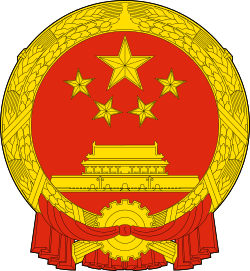Chinese foreign aid
| This article is part of a series on the |
| Politics of the People's Republic of China |
|---|
 |
| Commonly known as China |
|
|
|
China portal |
Foreign aid from China is development assistance provided by the Chinese government to other countries in the form of infrastructure projects given as gifts; concessional loans to fund projects; disaster relief; student scholarships; and other forms of assistance.[1]
History
The first instance of foreign aid by China to Africa was in 1956 during the Suez Crisis when China gave CHF 20 million to Egypt.[2] From 1970 and 1975, China helped finance and build the TAZARA Railway in East Africa, which remains the country's single-largest foreign aid project.
Administration and budget
The Department of Foreign Aid of the Ministry of Commerce (MOFCOM) is responsible for administrating the foreign aid program.[3] It does so in coordination with the Ministry of Foreign Affairs.[3] The portfolio of the Department of Foreign Aid includes grants, zero-interest loans, the youth volunteer program, and technical assistance.[3] The grants and interest free loans originate from the national budget.[3][4] The concessional loan program originates from the Export Import Bank of China but is managed under the direction of the Department of Foreign Aid.[3] In addition, the Department of Foreign Aid provides subsidies from the national budget covers the concessional component of loans.[3]
A RAND published study on "China's Foreign Aid and Government Sponsored Investment" estimates the amount of both traditional aid and much more broadly defined government sponsored investment that was pledged by China in 2011 was 189.3 billion US dollars.[4]
Forms of aid and recipients
Official sources divide aid into three categories: grants, interest free loans, and concessional loans.[4] Deborah Brautigam identifies in her book The Dragon's Gift nine types of aid from China including "medical teams, training and scholarships, humanitarian aid, youth volunteers, debt relief, budget support, turn-key or ‘complete plant’ projects [infrastructure, factories], aid-in-kind and technical assistance."[5]
Grants or non-interest loans have funded 2,025 complete infrastructure project, from the start of aid efforts up to 2009, in the categories of farming, water distribution, conference buildings, education facilities, power supply, transport, industrial facilities, and other projects.[6] Perhaps the famous type of project is a football stadium, which has been referred to as stadium diplomacy.[7] A similar type of project that receives attention is the construction of theatres and opera houses.[8]
There is an African focus with about 45% of aid going to African countries in 2009.[9] This is argued to be the result of China's increasing natural resources stake in Africa.[10]
See also
References
- ↑ Brautigam, Deborah (2011). "Aid 'With Chinese Characteristics': Chinese Foreign Aid and Development Finance Meet the OECD-DAC Aid Regime" (PDF). Journal of International Development.
- ↑ Li, Xiaoyun. "China's Foreign Aid and Aid to Africa" (PDF). OECD.
- 1 2 3 4 5 6 Bräutigam, Deborah (March 2010). "China, Africa and the International Aid Architecture". Africa Development Bank.
- 1 2 3 China’s Foreign Aid and Government-Sponsored Investment Activities (PDF). RAND. 2013.
- ↑ "Analysis: Behind China's aid structure". IRIN. September 17, 2013.
- ↑ "China's Foreign Aid". Xinhua. 2011-04-21.
- ↑ Foreign Aid: Diplomacy, Development, and Domestic Politics. The University of Chicago Press. 2007. p. 32.
- ↑ "An Opera House for Algeria". COMMANDOpera. April 21, 2010.
- ↑ "China Gives Almost Half of Foreign Aid to African Countrie". Bloomberg. April 21, 2011.
- ↑ Hsu, Jennifer Y. J.; Hildebrandt, Timothy; Hasmath, Reza (2016). "'Going Out' or Staying In? The Expansion of Chinese NGOs in Africa". Development Policy Review. Rochester, NY. 34(3): 1.